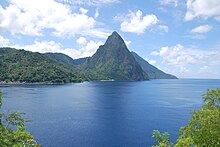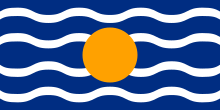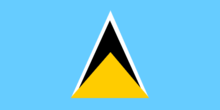History of St. Lucia
The story of St. Lucia is the story of the island of St. Lucia in the Caribbean, which has been independent since 1979 .
Immigration of the Arawak (approx. 200–400)
The first known inhabitants of the island were the Indian Arawak , who probably immigrated from South America around 200–400 AD . A number of archaeological finds attest to the high level of development of pottery among the islanders at the time. There is reason to believe that the Arawak called the island Iouanalao , which means “land of the iguanas”. Iguanas are abundant in St. Lucia.
Displacement of the Arawak by Caribs (approx. 800–1000)
In the period from 800 to 1000 AD, Caribs gradually displaced the Arawak. The new immigrants named the island Hiwanarau and later Hewanorra . The name Hewanorra International Airport of Vieux Fort Airport is derived from this. The Caribs had a complex society with hereditary royalty and shamans . Their war canoes held more than 100 men and were fast enough to overtake a sailing ship. Their ferocity in war was to fear later European invaders .
European invasion (from around 1500)
In 1492 or 1502 during the early Spanish explorations of the Caribbean, Europeans landed on St. Lucia for the first time and claimed it for Spain. In the 17th century, the Dutch , the English and the French tried to set up trading posts on the island, but met with determined resistance from the Caribs, whose land they wanted to occupy.
Franco-British rivalry in the 17th and 18th centuries
The French pirate Francois le Clerc (also known as Jambe de Bois - "the wooden leg ") visited St. Lucia in the 1550s. It was not until 1600 that the Dutch established the first European base on the island near today's Vieux Fort. Around 1605 an English ship named Olive Branch deviated from its course to Guyana in a storm and the 67 colonists established a settlement on St. Lucia. Within 5 weeks only 19 of them left the island due to diseases and conflicts with the Caribs.
The French officially claimed the island in 1635, but the next settlement was built by the English in 1639, but was soon wiped out by the Caribs. In 1651, the French arrived from the neighboring island of Martinique under the command of De Rousselan . They held the island for three years until the death of their commander.
In 1664 Thomas Warner (son of the governor of St. Kitts ) claimed St. Lucia for England. He brought 1000 men with him to defend them against the French. Mostly due to illness, only 89 of them survived the first two years. For the next few years, ownership of the island was negotiable under various treaties and moved back and forth between England and France.
| Franco-British rivalry for St. Lucia | |||
|---|---|---|---|
| date | Belonging to the island | ||
| 1635 | French claim, settlement 1651–1654 | ||
| 1664 | British occupation, settlement 1664–1666 | ||
| 1674 | French colony | ||
| 1723 | Neutral area according to the British-French agreement | ||
| 1743 | French colony of Sainte Lucie | ||
| 1748 | Neutral area according to the British-French agreement | ||
| 1756 | French colony of Sainte Lucie | ||
| 1762 | British occupation | ||
| 1763 | Return to France | ||
| 1778 | British occupation | ||
| 1783 | Return to France | ||
| 1798 | British occupation | ||
| 1802 | Return to France | ||
| 1803 | British Colony of St. Lucia | ||
| 1814 | Confirmation of British ownership | ||
Both for the English, whose headquarters were on the island of Barbados , and for the French, whose main base was the island of Martinique , St. Lucia became more attractive with the increasing development of the sugar industry . With the Treaty of Paris in 1763 , the French gained sovereignty over the island and in 1765 they introduced sugar plantations. The colonists who now came to the island were mostly white men who were obliged to work and served a small group of wealthy merchants and nobles .
On December 15, 1778, during the American War of Independence , the battle of the saints broke out between the French and British navies . Admiral Rodney, whose fleet left the port of St. Lucia, beat the French Admiral De Grasse. Through this battle the British maritime superiority in the Caribbean was secured for a long time.
At the end of the century the French Revolution broke out and a revolutionary tribunal led by Captain La Crosse was dispatched to St. Lucia. But even before his arrival, the slaves had refused to obey their masters and had begun to work for themselves. La Crosse wanted to impose the ideas of the revolution on the island and set up a guillotine on order royalists , so supporters of the House of Bourbon to execute. In 1794 the French governor of the island declared all of St. Lucia's slaves to be freed.
Shortly afterwards, the British, summoned by wealthy plantation owners, occupied the island and, after years of fighting, reintroduced slavery. The capital, Castries , was burned down in 1796 in the course of these clashes between the British, former slaves and the French.
British Colony St. Lucia (from 1803/14)
Great Britain triumphed in 1803 and took permanent possession of St. Lucia in 1814. The British abolished the slave trade in 1807 , three years after former slaves on the island of Hispaniola gained independence as the first black republic in the Caribbean in a bloody uprising, the Haitian Revolution . It was not until 1834 that they abolished the institution of slavery themselves. But even after the official liberation of slaves, the blacks - as in many other places in the Caribbean - had to go through a four-year forced "training period" during which they had to continue to work for their former masters for three quarters of the week. In 1838 they finally achieved full freedom.
Also in 1838, St. Lucia was incorporated administratively into the British Windward Islands , whose headquarters were in Barbados. In 1885 the capital was relocated to Grenada .
Increasing independence in the 20th century
St. Lucia's history in the 20th century was characterized by increasing self-determination. 1924 joined a Constitution in force, which first brought a form of representative government of the island, but with a minority of elected members in the Legislative Council ( Legislative Council ), whose members were otherwise appointed, not elected. Since the elections to the National Assembly in 1951, the principles of universal, equal, secret and direct suffrage, including women's suffrage, have applied . The right was first exercised on October 13, 1951. A ministerial government had existed since 1956.
independence
In 1958, St. Lucia joined the short-lived West Indian Federation , a semi-autonomous state structure dependent on the United Kingdom and comprising a dozen British island colonies from Grenada to Jamaica. After the collapse of the federation due to internal disagreements in 1962, there was a similar attempt with a smaller number of members and without the overpowering Jamaica, but this federation also failed. The United Kingdom and the islands of Grenada, St. Vincent , Dominica , Antigua , St. Kitts and Nevis , Anguilla , and St. Lucia then formed a new form of cooperation, known as the "Associated State".
As an associated state with Great Britain, St. Lucia had full internal self-government from 1967 to 1979, while foreign affairs and defense were left to Great Britain.
independence
On February 22, 1979, St. Lucia gained full independence. The active and passive right to vote for women was confirmed.
The state continues to recognize Queen Elizabeth II as the formal head of state and is an active member of the Commonwealth of Nations . For the national anthem , the song was Sons and Daughters of Saint Lucia stated that was a hymn in use since the autonomy 1967th From 1979 to 1982 the new state was ruled by the socialist Saint Lucia Labor Party . From 1982 the conservative-liberal United Workers Party ruled with Prime Minister John Compton , who held office with interruptions until 2006. Stephenson King has been Prime Minister of the island since his death in 2007 .
St. Lucia continues to cooperate with its former British neighboring islands and some other Caribbean states in the Caribbean Community (CARICOM), the predecessor of which was the Eastern Caribbean Common Market (ECCM) and the Organization of Eastern Caribbean States (OECS). The island is also a member of the Alliance of Small Island States .
In 1992, with Derek Walcott , a born Lucian received a Nobel Prize , the Nobel Prize for Literature, for the first time . If you add the Alfred Nobel Memorial Prize for Economics to the Nobel Prizes, then William Arthur Lewis was awarded a Nobel Prize to a Lucian as early as 1979, in the year of independence, and St. Lucia would have the second highest rate of Nobel Prizes per inhabitant.
literature
- Don Philpott: St Lucia . Landmark Publishing, Derbyshire 1999, ISBN 1-901522-28-8 .
- Chris Higgins: St. Lucia . Ulysses Travel Guides, Montreal 2001, ISBN 2-89464-396-9 .
Web links
Individual evidence
- ↑ worldstatesmen.org
- ^ Bernd Hillebrands: St. Lucia. In: Dieter Nohlen (Ed.): Handbook of the election data of Latin America and the Caribbean (= political organization and representation in America. Volume 1). Leske + Budrich, Opladen 1993, ISBN 3-8100-1028-6 , pp. 687-693, p. 689.
- ↑ Dieter Nohlen (Ed.): Handbook of the election data of Latin America and the Caribbean (= political organization and representation in America. Volume 1). Leske + Budrich, Opladen 1993, ISBN 3-8100-1028-6 , p. 689
- ↑ a b - New Parline: the IPU's Open Data Platform (beta). In: data.ipu.org. October 13, 1951, accessed September 28, 2018 .






